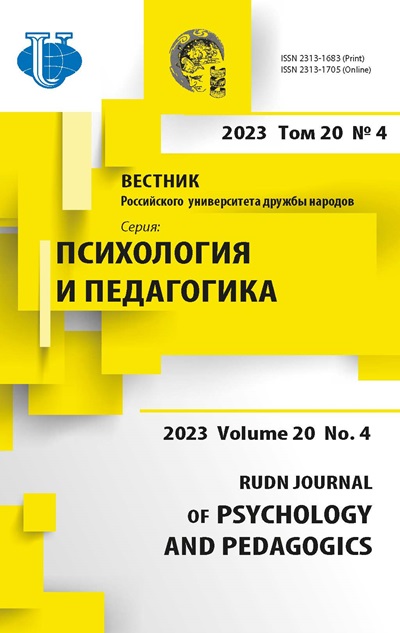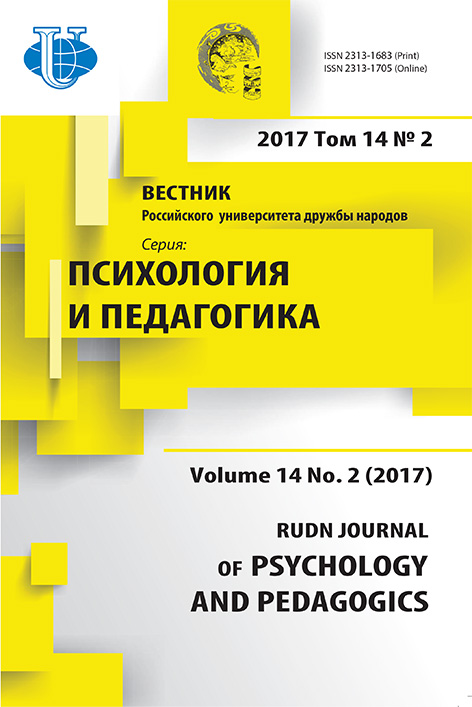Том 14, № 2 (2017)
- Год: 2017
- Статей: 10
- URL: https://journals.rudn.ru/psychology-pedagogics/issue/view/960
- DOI: https://doi.org/10.22363/2313-1683-2017-14-2
Весь выпуск
Статьи
РАЗВИТИЕ ТАЛАНТА В ОБЛАСТИ КЛАССИЧЕСКОЙ МУЗЫКИ И ИЗОБРАЗИТЕЛЬНОГО ИСКУССТВА
Аннотация
В статье предлагается рассмотреть траектории развития детей, одаренных в музыкальной сфере (прежде всего, сфере классической музыки) и в области изобразительного искусства. Кратко представлена модель развития таланта, разработанная применительно к классической музыке, а также обсуждается возможность ее приложения в сфере изобразительного искусства.
 131-142
131-142


НАСТОЙЧИВОСТЬ И УЧЕБНЫЕ ДОСТИЖЕНИЯ СТУДЕНТОВ ЕСТЕСТВЕННО-НАУЧНЫХ НАПРАВЛЕНИЙ ПРИ ОСВОЕНИИ ИНОСТРАННОГО ЯЗЫКА
Аннотация
В статье рассматриваются результаты эмпирического исследования связи переменных настойчивости и академических достижений студентов при освоении ими иностранного языка. Выборку исследования составили студенты факультета физико-математических и естественных наук РУДН (n = 115), разделенные на 5 подвыборок, две из которых подробно описаны в настоящем исследовании (подвыборки наиболее и наименее успешных учащихся). Настойчивость как черта личности изучается в рамках системно-функционального подхода А.И. Крупнова. Для измерения переменных настойчивости использовался бланковый тест А.И. Крупнова. Академические достижения были измерены в соответствии с четырьмя параметрами: фонетика, грамматика, речь и политическая лексика, основанных на оценках учащихся, полученных в течение учебного года. Анализ показал, что настойчивость демонстрирует различные связи с переменными успеваемости у более и менее успешных в освоении иностранного языка студентов, причем эти связи более выражены у менее успешных студентов. Фонетика как навык, который можно приобрести благодаря упорной работе и практике, наиболее тесно связана с настойчивостью. Грамматика практически не связана с настойчивостью, но, вероятно, связана с другими факторами академических достижений. Менее успешные студенты могут испытывать трудности с отделением различных аспектов освоения языка друг от друга, что должны быть учтено в педагогической работе.
 143-154
143-154


ИНДИВИДУАЛЬНО-ПСИХОЛОГИЧЕСКИЕ ОСОБЕННОСТИ ПЕРЕВОДА КАК СОСТАВЛЯЮЩИЕ ЯЗЫКОВЫХ СПОСОБНОСТЕЙ
Аннотация
В статье рассматриваются дифференциально-психологические аспекты способности к переводу как составляющей языковых способностей (ЯС). Показана специфика переводческой деятельности как процесса, включающего как лингвистические, так и паралингвистические аспекты передачи содержания и смысла текста с одного языка на другой, сопровождающегося языковыми и когнитивными операциями. Выделены индивидуально-психологические особенности перевода, основанные на доминанте перевода. Показано, что эти различия соотносимы с коммуникативно-речевыми и когнитивно-лингвистическими типами ЯС, выделенными М.К. Кабардовым. На основе эмпирического исследования с использованием как хорошо апробированных методик диагностики «художественного» и «мыслительного» типов ВНД (М.Н. Борисовой) и соотношения вербального и невербального интеллекта (Д. Векслера), так и авторских исследовательских методик, выявляющих индивидуальную специфику переводческой деятельности, выделены коммуникативно-речевой и когнитивно-лингвистический типы языковой способности к переводу. Показано, что в основе дифференциально-типологических различий лежат специфические человеческие типы высшей нервной деятельности (ВНД). Выявлено, что представители мыслительного типа выполняют перевод иностранных языковых конструкций, опираясь преимущественно на лингвистические приемы, что подтверждает их принадлежность к когнитивно-лингвистическому типу языковой способности; представители художественного типа при передаче смысла текста демонстрируют ориентацию на субъективно значимую информацию, опираясь на экстралингвистические приемы, что свидетельствует о принадлежности их к коммуникативно-речевому типу языковой способности. Показано, что у представителей крайних типов «художников» и «мыслителей» имеется тенденция при выполнении заданий на перевод иностранных языковых конструкций компенсировать недостаточно развитые компоненты способности одного типа более развитыми компонентами способности другого языкового типа, что проявляется в успешности выполнения ряда заданий, востребующих как вербального, так и образного интеллекта, и«художниками», и «мыслителями».
 155-166
155-166


НЕЗАЩИЩЕННОСТЬ ОТ МАНИПУЛЯЦИЙ И ЕЕ СВЯЗИ С КОГНИТИВНЫМИ И ЛИЧНОСТНЫМИ ХАРАКТЕРИСТИКАМИ ПОДРОСТКОВ
Аннотация
В статье предложен подход к решению междисциплинарной проблемы поиска когнитивных и личностных характеристик подростков 14-16 лет, подверженных манипулятивному воздействию со стороны окружающих. Выявлен ряд качеств подростков, способствующих их незащищенности от манипуляций, и установлены связи между этими качествами личности. Показано, что характер влияния этих качеств существенно зависит от биологического и психологического пола подростка. У юношей незащищенность от манипуляций положительно коррелирует с показателями их интернальности, маскулинности, андрогинности, уверенности в себе, социальной смелости, со склонностями к работе с людьми, к эстетическим, экстремальным и планово-экономическим видам деятельности. У девушек незащищенность от манипуляций отрицательно коррелирует с показателями их интернальности, маскулинности, уверенности в себе и словесно-логического мышления, но положительно связана со склонностью к работе с людьми. Интернальность юношей и девушек положительно коррелирует с маскулинностью, уверенностью в себе, с социальной смелостью, а у юношей - еще и с креативностью мышления и со склонностью к экстремальным видам деятельности. Маскулинность у юношей и девушек положительно связана с уверенностью в себе, с социальной смелостью, инициативой в социальных контактах и со склонностью к экстремальным видам деятельности. У юношей и девушек уверенность в себе положительно связана с креативностью мышления, со склонностью к экстремальным видам деятельности и с инициативой в социальных контактах. У юношей и девушек имеют место положительные взаимные корреляции между уверенностью в себе, социальной смелостью и инициативой в социальных контактах. Юноши в сравнении с девушками в большей степени незащищены от манипуляций, более интернальны и уверены в себе, обладают большей социальной смелостью. У девушек выше средние показатели в наглядно-образном и словесно-логических типах мышления, в склонности к работе с людьми и к эстетической деятельности. У юношей выше средние показатели абстрактно-символического мышления, склонности к исследовательской, практической и экстремальной деятельности. Обнаружены признаки феминизации юношей.
 167-177
167-177


ВЗАИМОСВЯЗЬ ПСИХОЛОГИЧЕСКИХ ХАРАКТЕРИСТИК ВНУТРЕННЕЙ КАРТИНЫ БОЛЕЗНИ И КОПИНГ-ПОВЕДЕНИЯ ПАЦИЕНТОВ С ИШЕМИЧЕСКОЙ БОЛЕЗНЬЮ СЕРДЦА С ПАРАМЕТРАМИ ИХ КОГНИТИВНОГО СТАТУСА
Аннотация
В настоящей работе представлено исследование взаимосвязи между внутренней картиной болезни, копинг-поведением пациентов с ишемической болезнью сердца (ИБС) перед коронарным шунтированием (КШ) с показателями их когнитивного статуса. Для проведения исследования был использован Личностный опросник Бехтеревского института (ЛОБИ), опросник «Способы совладающего поведения» Р. Лазаруса, Краткая шкала оценки когнитивных функций (Mini-Mental State Examination, MMSE), тест «Батарея лобной дисфункции» (FAB) и тест «Рисование часов». Приведены результаты исследования 132 пациентов, которое показало, что у пациентов с ИБС до проведения КШ чаще всего наблюдается гармоничный тип картины заболевания или сочетание гармоничного и эргопатического типа отношения к болезни. Среди предпочитаемых копинг-стратегий были выделены дистанцирование, конфронтация и планирование решения проблем. Были выявлены положительные корреляции параметров когнитивного статуса с гармоничным, эргопатическим и ипохондричным типом отношения к болезни, и отрицательные - с анозогнозической и сенситивной картиной болезни. Кроме того, были выявлены положительные взаимосвязи показателей когнитивного статуса и копинг-стратегий «Конфронтация», «Самоконтроль», «Принятие ответственно- сти», «Планирование решения проблем», «Положительная переоценка», и отрицательные взаимосвязи с копинг-стратегиями «Дистанцирование» и «Бегство-избегание». Результаты проведенного исследования позволяют повысить уровень диагностической и реабилитационной психологической помощи пациентам с ИБС при подготовке к КШ.
 178-189
178-189


КУЛЬТУРНО-ЦЕННОСТНЫЕ ОРИЕНТАЦИИ РОССИЙСКИХ (РУССКИХ И БУРЯТ) И МОНГОЛЬСКИХ СТУДЕНТОВ
Аннотация
В статье представлены результаты эмпирического исследования культурно-ценностных ориентаций российских (русских и бурятских) и монгольских студентов. В качестве респондентов выступили студенты гуманитарных направлений вузов Улан-Удэ, РФ (388 человек) и Улан-Батора, Монголия (176 человек). Были использованы психодиагностические методики: «Тест культурно-ценностных ориентаций» Л.Г. Почебут, шкала Р. Инглхарта в модификации М.С. Яницкого. В ходе анализа было установлено, что доминирующим культурным типом среди молодежи Бурятии и Монголии является современная культура. Имеются различия в приверженности к традиционной и динамически развивающейся культуре, обусловленные этнической принадлежностью: бурятские студенты в большей степени привержены традиционной и современной культуре и менее ориентированы на динамически развивающуюся культуру; русские студенты в большей степени ориентированы на традиционную и динамически развивающуюся культуру и менее ориентированы на современную культуру; монголы в большей степени ориентированы на динамически развивающуюся культуру и менее ориентированы на традиционную культуру. Молодежь Бурятии в большей степени привержена ценностям адаптации и социализации, чем молодежь Монголии. Имеются различия в приверженности ценностям индивидуализации у российских студентов: данные ценности в большей степени выражены у русских студентов. Выявленные различия интерпретируются как этнопсихологические особенности молодежи и рассматриваются в качестве возможных ресурсов развития толерантности, преодоления системного кризиса современного общества.
 190-200
190-200


ДВИЖЕНИЯ В СТРУКТУРЕ РЕШЕНИЯ ИНСАЙТНЫХ ЗАДАЧ (НА МАТЕРИАЛЕ ЗАДАЧИ 9 ТОЧЕК)
Аннотация
Существующие данные о влиянии сопутствующей или предшествующей моторной активности на процесс решения мыслительных задач не укладываются в современные теории инсайта. В связи с этим требуется более детальное изучение моторной активности в ходе решения инсайтных задач. Данное исследование посвящено изучению закономерных изменений моторной активности в процессе решения классической инсайтной задачи «9 точек». Для фиксации параметров моторной активности (длина моторных единиц, скорость реализации моторных единиц, продолжительность пауз между моторными единицами) и предъявления условий задачи использовался планшетный компьютер. В результате были выявлены устойчивые различия в моторике между успешными и неуспешными решателями на начальном и конечном этапах решения задачи. Оказалось, что у успешных решателей длина моторных единиц (особенно на конечном этапе решения) больше, чем у неуспешных. При этом различия в продолжительности пауз между моторными единицами на начальном и конечном этапах решения не были найдены. Испытуемые, решившие и не решившие задачу, не отличаются по продолжительности пауз между моторными единицами. Было обнаружено, что на конечном этапе увеличивается частотность «быстрых» линий, которые могут быть связаны преимущественно с «оффлайн» планированием моторной активности, т.е. планированием, предшествующим самой активности, а не протекающим параллельно с ней.
 201-212
201-212


ПСИХОДИАГНОСТИЧЕСКАЯ МЕТОДИКА ОЦЕНКИ СОЦИАЛЬНО-ПЕРЦЕПТИВНОЙ УСТАНОВКИ ЛИЧНОСТИ: ПСИХОМЕТРИЧЕСКИЕ ХАРАКТЕРИСТИКИ И ОСОБЕННОСТИ ИСПОЛЬЗОВАНИЯ
Аннотация
Социально-перцептивная установка определяется как предрасположенность субъектов общения воспринимать, оценивать и действовать по отношению друг к другу определенным образом. Функциями социально-перцептивной установки являются: социально-приспособительная (утилитарная), когнитивная, экспрессивно-оценочная, психологической защиты. Представлена авторская методика диагностики социально-перцептивной установки личности по отношению к другим людям. В качестве стимульного материала предлагаемой диагностической методики выступили пословицы народов мира. Результаты психометрической проверки свидетельствуют о надежности и валидности методики. Высокие баллы по результатам диагностики говорят о свойственном личности: готовности доверять, помогать и замечать позитивное; умении видеть позитивный потенциал; вере в способности людей развиваться и достигать более высоких результатов; эмоциональном принятии, доброжелательности, эмпатии. Средние показатели говорят о стремлении испытуемого к близким и доверительным отношениям, сотрудничеству, искренности; старании понять другого человека; стремлении учитывать индивидуально-психологические особенности других людей; противоречия с другими либо отсутствуют, либо конструктивно разрешаются. Низкие показатели свидетельствуют о том, что испытуемому свойственны по отношению к другим людям: подозрительность, ожидание негативного отношения к себе, игнорирование их успехов и достижений; эмоциональное неприятие, критика, ирония, злорадство; обвинения в адрес других используются для оправдания своих негативных действий (агрессии) в отношении их.Методика может использоваться для решения задач психодиагностики, психокоррекции, консультирования в целях оптимизации общения и межличностных отношений: достижения взаимопонимания, сотрудничества, принятия конструктивного обоюдовыгодного решения, преодоления стремления к критике другого человека.
 213-225
213-225


АНТИЧНЫЕ ОСНОВАНИЯ ЕДИНСТВА ОБРАЗОВАНИЯ
Аннотация
Под единством образования автор статьи понимает его представление в качестве особого способа существования, т.е. стирание различия между онтологической и антропологической трактовками феномена. Предполагается, что такой подход позволяет адекватно определить философский смысл категории образования, не связывая его исключительно с философским рассмотрением практики обучения и воспитания. Автор также указывает на наличие в истории европейской философии связи между идеей единства мира и идеей образования человека как процесса постепенного приближения к его истинному и завершенному образу. Несмотря на то, что наиболее значимой для современного понимания образования остается его разработка в немецкой классической философии, автор стремится показать перспективность обращения к античной философской традиции, предложившей первую концептуализацию образования, связанную с особой онтологической позицией. Автор обращает внимание на постепенное становление представлений о системном характере бытия, связывая его с исходной дидактической установкой греческих философов. Также на примере этики Аристотеля, подчеркивается единство внешне разделенных путей становления человека. Автор приходит к выводу о необходимости принимать во внимание связь представлений об образовании с характерным стремлением построить философскую теорию мира, все элементы которого объединены в единую систему. По его мнению, это позволит определить действительный философско-педагогический смысл пересмотра классической философской традиции, предпринятого новейшей философией.
 226-236
226-236


КОНФЕРЕНЦИИ
ТРЕТИЙ МЕЖДУНАРОДНЫЙ СИМПОЗИУМ «МЕНТАЛЬНЫЕ РЕСУРСЫ ЛИЧНОСТИ: ТЕОРЕТИЧЕСКИЕ И ПРИКЛАДНЫЕ ИССЛЕДОВАНИЯ»
 237-242
237-242
















